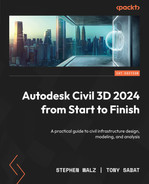1
Introduction to Civil 3D
Autodesk’s Civil 3D has been the leading design authoring tool of choice supporting civil engineering design applications since the early 2000s. Designers working with Civil 3D are able to put their knowledge to work with this practical guide to civil engineering design. This textbook is intended for civil designers with a basic understanding of Civil 3D and its workflows.
With this book, you will learn how best to configure and manage your civil engineering designs by successfully leveraging all that Autodesk Civil 3D has to offer.
We will begin by exploring best practices and real-world applications that will elevate your designs with Civil 3D. Autodesk Civil 3D connects to an entire network of other platforms and technologies to take your project further than you would imagine for civil engineering designs. By the end of this book, you will have a thorough understanding of Autodesk’s Civil 3D and will be able to strategize how best to utilize it in your next project.
In this chapter, we will provide some background and history to help you realize the benefits of leveraging Autodesk’s Civil 3D and understand its place within the Architeture, Engineering and Construction (AEC) industry. We will then familiarize ourselves with the overall user interface to understand all the tools and functionality available within Autodesk’s Civil 3D, allowing you to maintain a high level of efficiency as you work through your design(s). Finally, to gain all of the benefits that Civil 3D has to offer and maintain a high level of efficiency and consistency, you’re going to learn how to leverage as much of Civil 3D’s dynamic capabilities as possible to support your Building Information Modeling (BIM) design(s).
So, in this chapter, we will cover the following topics:
- What is Civil 3D?
- The user interface
- Understanding Civil 3D elements
Technical requirements
It’s important to note that Autodesk’s Civil 3D can often be very taxing to your computer. There is a lot of processing that goes on with modeled design elements, even in the background, that enables the dynamic (connected) capabilities to occur throughout the BIM design life cycle. In turn, there are many technical requirements that need to be considered to allow Autodesk’s Civil 3D to operate at its full potential. Here, we’ll review the minimum requirements that Autodesk recommends, with a few of my suggestions added to increase efficiency and speed throughout the BIM design process:
- Operating system – 64-Bit Microsoft Windows 10
- Processor – 3+ GHz
- Memory – 16 GB RAM (I suggest going with either 64 GB or 128 GB)
- Graphics card – 4 GB (I suggest going with 8+ GB)
- Display resolution – 1980 x 1080 with True Color
- Disk space – 16 GB
- Pointing device – MS-Mouse compliant
What is Civil 3D?
We’ve all heard the term BIM being thrown around for quite some time now. In general, BIM is the process typically applied to and associated with intelligently and dynamically designing an actual building or structure, where architects/engineers and designers can visualize and anticipate the true constructability of a project.
On the survey and civil engineering side, we’ve been generating, designing, and modeling everything outside buildings/structures in a 3D environment for just as long, if not longer, than the term BIM has been around. However, for one reason or another, these designs have not typically been viewed as BIM by the vast majority.
This is where Autodesk’s Civil 3D comes into the picture. Civil 3D is essentially a BIM design authoring tool that fully supports both surveying and civil engineering designs. When utilized the right way, we have the power to create and manage intelligently designed models, perform cost estimations, interfence checks/clash detections, prepare our models for construction sequencing, and even perform asset management integrations well beyond design.
It’s important to note that Autodesk’s Civil 3D is considered a vertical application of Autodesk’s AutoCAD. A vertical application in this context essentially means that Civil 3D is built on top of AutoCAD, thereby still providing a lot of 2D-focused tools and functionality. To make the transition from 2D to 3D, we’ll need to realize the separation of where the content resides and how the application of tools differs in each world. Throughout the course of this book, I will cover both 2D and 3D applications of design intent to provide a bit more insight as to how and when to apply each of them.
Historically, it is always recommended that anyone looking to fully utilize Civil 3D should have a basic understanding of AutoCAD to establish that foundation. Depending on the individual learning, that concept is more frequently dismissed as it has the potential to root bad design habits in those not willing to fully embrace the 3D world. As Civil 3D continues to evolve and become more of a model-centric focused design authoring tool, the industry has a much better opportunity to fully embrace the concept of BIM and design with intelligence from the beginning.
What types of BIM projects can Civil 3D manage?
When trying to determine how Civil 3D can best be utilized from a design standpoint, we’re going to break down the tools and functionality into the following three main design categories or markets: land development, utilities, and transportation. In addition to the three main design categories, it’s important to realize all projects, whether building or infrastructure, rely upon existing conditions, and Civil 3D is a great partner for hosting these parameters as well as modeling new ones for a complementary design to the interior of the structure. This added benefit is heavily relied on and supported in the surveying industry as well.
In this course, we’ll cover all four of these categories in great length as follows:
- From a surveying perspective, we’ll cover tools that allow for full integration of survey databases, field books, existing conditions modeling, and even point cloud integration from drone and laser scan technology. Any BIM design being generated can only be as accurate as the survey and existing conditions model, making these early steps critical to successful design downstream.
- From a land development perspective, we’ll cover methods that allow a wide array of civil site designs including subdivisions, residential/commercial sites, parks, and even environmental designs.
- From a utility perspective, we’ll cover tools and functionality that support storm drainage, sanitary sewer, waterline, and natural gas designs.
- From a transportation perspective, we’ll cover tools and functionality that support roadway designs, rehabilitations, and access roads. Additionally, we’ll cover tips and tricks on how some of these tools can be applied in civil site designs and even stream and restoration projects.
Understanding real-world applications of any new technology solution is critical from an overall adoption and implementation standpoint. Throughout this book, especially as we dive deeper into the specific tools and functionality of Autodesk’s Civil 3D, we’ll begin to understand how and why it is viewed as a leading design authoring tool supporting the AEC industry.
Let’s go ahead and jump into the program to begin to familiarize ourselves with the user interface to get an idea of where to locate all of the tools and functionality available to us.
Exploring the Civil 3D user interface
With all the introductions and background out of the way, let’s go ahead and jump into Autodesk Civil 3D and get acquainted with this BIM platform. When Autodesk Civil 3D is opened up or launched, you will be presented with the Start tab/screen, similar to that shown in Figure 1.1:

Figure 1.1 – User interface when Autodesk’s Civil 3D is launched
If we then select the + sign next to the Start tab, we will see we have essentially created our first drawing and will be presented with a screen similar to that shown in Figure 1.2:

Figure 1.2 – User interface after our first drawing has been created
Along the very top of the program, you are presented with three levels of tools and functionality, as shown in Figure 1.3:

Figure 1.3 – Top three levels of tools and functionality within the user interface
Each of these levels provides varying access to the tools and functionality available within Autodesk’s Civil 3D platform. Much of this should be a bit clearer by the end of the section, as we dive into more detail about what is available at each level.
The first tier of the ribbon
In the first level at the very top, reading from left to right, we have access to the Menu browser, Quick Access Toolbar, Workspace and Quick Access Toolbar Customizations, Application and Drawing currently visible in the Drawing area, Quick Search Access to Autodesk’s Civil 3D Help, Autodesk Account Access, Overall Autodesk’s Civil 3D Help, and Quick program visibility access.
Starting with the Menu browser, which is indicated by the Civil 3D icon in the top-left corner of the program, you will be presented with a multitude of options that will provide some very high-level drawing management and functionality. Select the icon by left-clicking on your mouse (refer to Figure 1.4 for a detailed view of the Menu browser):
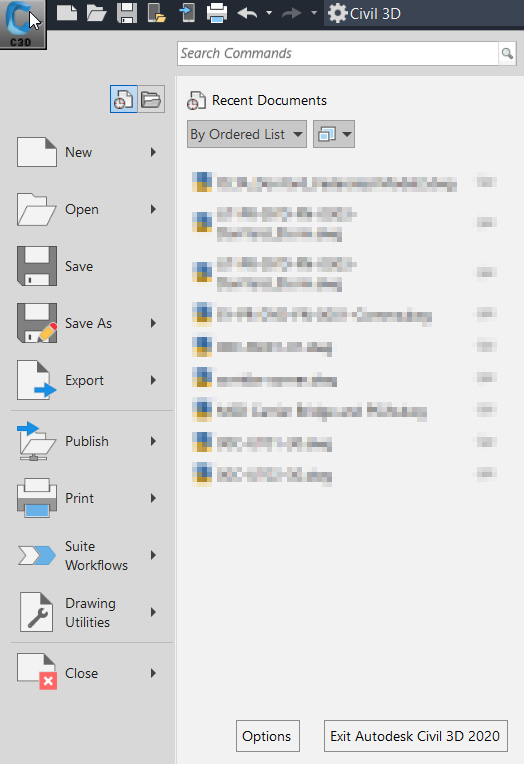
Figure 1.4 – Detailed view of the Menu browser
Running through the options presented along the left side of the Menu browser from the top to the bottom, the following list details what each area provides:
- New: This selection allows end users to create new drawings and sheet sets (more on sheet sets in Part 4 of the book).
- Open:This selection allows end users to open existing drawings (both locally or web and mobile-based), access Sheet Set Manager, import DGN files (Microstation format), import Industry Foundation Class (IFC) files, and open sample files (both locally or from online).
- Save: This selection allows end users to perform a quick save of their current drawing.
- Save As: This selection allows end users to save their current drawing as another drawing (both locally or web and mobile-based), drawing template file, drawing standards file, other formatted files (that is, DWG, DWDT, WS, and DXF), save the layout as a drawing file, and DWG Convert which will allow us to save to a DWG format that is compatible with earlier releases of Civil 3D).
- Export: This selection allows end users to export their current drawing to a DWF, DWFx, 3D DWF, another DWG version, DGN, DXF, PDF, IFC, and other file formats (that is, WMF, SAT, STL, EPS, DXX, BMP, IGES, and IGS).
- Publish: This selection allows end users to access the Send to Print service, Archive, eTransmit, Email, and Share View.
- Print: This selection allows end users to access Plot, Batch Plot, Plot Preview, View Plot and Publish Details, Page Setup, 3D Print, Manage Plotter, Manage Plot Styles, and Edit Plot Style Tables.
- Suite Workflows: This selection allows end users to access Workflow Manager, a dedicated area for common automated tasks.
- Drawing Utilities: This selection allows end users to access Drawing Properties, DWG Compare, Drawing Settings, Units, Audit, Status, Purge, Recover, Open the Drawing Recovery Manager, and Update Block Icons.
- Close: This selection allows end users to close the current drawing or all drawings.
Moving onto Quick Access Toolbar, we have a lot of the same options available to us as are within the Menu browser. However, instead of a drop-down menu like that of the Menu browser, we quick-select icons of tools and functionality that are typically common to everyday workflows:
Figure 1.5 – Quick Access Toolbar
Running through the stock, out-of-the-box Quick Access icons from left to right (as shown in Figure 1.5), we have the following:
- New
- Open
- Save
- Open from Web & Mobile
- Save to Web & Mobile
- Plot (print)
- Undo
- Redo
Note
Next to the Undo and Redo icons in Quick Access Toolbar, there are down arrows that will allow you to select the number of steps for which you would like to perform that operation on your drawing. By simply selecting the icon instead of the down arrow, you will perform that operation once for each click of the mouse. If you are intending to perform that operation multiple times, I recommend using the down arrow next to the icon to get the drawing back to the state that you are expecting.
If there are additional tools that are typical to your everyday workflow, there is a way to add them to your toolbar by simply right-clicking on the tool in the ribbon and selecting Add to Quick Access Toolbar.
Next, we have the Workspace and Customized Quick Access toolbar. Here you can change the tools available in the ribbons on the third and fourth levels depending on the type of design and analysis you are looking to perform within the current drawing. To change from one workspace to another, you can select the down arrow icon next to the workspace name and select a different one as appropriate (see Figure 1.6).

Figure 1.6 – Workspace selections
Workspaces displayed and available include the following:
- Civil 3D: Tools displayed in the ribbon will provide you with the bulk of the tools necessary to perform civil engineering design and analysis.
- Drafting & Annotation: Tools displayed in the ribbon will provide you with the basic 2D drafting tools and functionality.
- 3D Modeling: Tools displayed in the ribbon will provide you with the basic 3D modeling tools and functionality. It’s important to note that 3D modeling capabilities within this display are not Civil 3D-related but are more intended for basic AutoCAD functionality.
- Planning and Analysis: Tools displayed in the ribbon will provide you with additional mapping and analysis tools. These tools come in handy when connecting to ArcGIS data.
- Save Current As…: Provides the ability to save any customizations you have made to a customized workspace that can be made current later on.
- Workspace Settings…: Selecting this option will pull up another dialog box that will allow you to define which workspaces are available, as well as the display order of the workspaces listed.
- Customize…: Selecting this option will pull up another dialog box that will allow you to customize any of your workspaces if necessary. This will come in handy if you intend to create custom tools, layouts, and so on specific to your workflow.
Directly next to the workspace selections is another down arrow with a horizontal line above it. If you select this, you will be presented with a drop-down menu that will provide the ability to customize Quick Access Toolbar and Tools Available within the overall ribbon interface (refer to Figure 1.7):

Figure 1.7 – Customize Quick Access Toolbar
Those items that are checked will be displayed in Quick Access Toolbar in your current view. You’ll notice that all of those checked in Figure 1.7 were those that were displayed when we were reviewing Quick Access Toolbar (Figure 1.5). The remaining tools listed in the top section are fairly straightforward and are typical commands and functionality that are relied on for a lot of workflows, hence the reason why they are listed as optional defaults in the list.
The last option in Quick Access Toolbar is an icon that looks like a paper airplane (see Figure 1.8). Selecting this icon will allow you to share the current drawing via a link to a web-based version. By default, the drawing is only available for 7 days.
Figure 1.8 – Share the drawing with a link
Next, we have Application and Drawing currently visible in the drawing area (refer to Figure 1.9). As you open or create and save new drawings, the drawing name displayed in this location will update accordingly.
Figure 1.9 – Application and Drawing
Then, we move on to Quick Search Access to Autodesk’s Civil 3D Help (refer to Figure 1.10). Any time you find yourself needing some quick help on a specific command, simply type the name of the command in this location and click on the magnifying glass icon next to it. After selecting the magnifying glass icon, another window will appear that contains the Civil 3D Help documentation and will present you with results that match the keyword or phrase you had typed into the field.
Figure 1.10 – Quick Search Access
Next up is Autodesk Account Access. Viewing from left to right, we first have Account Login and Details presented to you. When selecting the down arrow icon in the view (refer to Figure 1.11), you will have the ability to log out, view account details, explore purchase options, and manage licenses.
Figure 1.11 – Autodesk Account Access
Next to Autodesk Account Access (refer to Figure 1.12), we are presented with the option to connect to the Autodesk App Store (indicated by the shopping cart icon) and to connect to Civil 3D user networks via Facebook and Twitter:
Figure 1.12 – Autodesk App Store and user group networks
Continuing on, we have the overall Autodesk Civil 3D Help access, which is identified by the question mark icon (see Figure 1.13):
Figure 1.13 – Autodesk Civil 3D Help
And finally, we come to the quick program visibility access, where we have the ability to minimize the window of the program, restore and maximize the window of the program, and close the entire program:
Figure 1.14 – Quick program visibility
With the contents of the first tier behind us, let’s jump into the second tier.
The second tier of the ribbon
In the second level of the ribbon interface, we have the tabs that essentially group all of the tools and functionality available within Autodesk’s Civil 3D (refer to Figure 1.15). This grouping is meant to be an easy way to quickly access tools as you need them, instead of having to search through the drop-down menus for tools as needed.

Figure 1.15 – Second tier
Starting with the Home tab (refer to Figure 1.16), we have quick access to many of the major design tools and functionality that we will be leveraging through the BIM design life cycle:

Figure 1.16 – Home
Next up is the Insert tab (refer to Figure 1.17), where we can quickly make connections to other types of files for reference purposes. Based on the type of file(s) being referenced, we can either keep these as static overlays being displayed or can make them live elements within our drawing area:

Figure 1.17 – Insert
Next up is the Annotate tab (refer to Figure 1.18), where we can quickly add labels and text to various design elements:

Figure 1.18 – Annotate
Next up is the Modify tab (refer to Figure 1.19), where we can quickly adjust design elements within the drawing:

Figure 1.19 – Modify
Next up is the Analyze tab (refer to Figure 1.20), where we can quickly access various reporting and computational tools and functionality available to us:

Figure 1.20 – Analyze
Next up is the View tab (refer to Figure 1.21), where we can quickly adjust our display settings of modeled elements in our drawing area:

Figure 1.21 – View
Next up is the Manage tab (refer to Figure 1.22), which, in a way, is more of a parking lot that provides quick access to a multitude of options, such as connecting to individual design elements from other Civil 3D files, performing customizations to the overall user interface, and file cleanup options:

Figure 1.22 – Manage
Next up is the Output tab (refer to Figure 1.23), where we can quickly export our drawing and individual design elements to a variety of formats:

Figure 1.23 – Output
Next up is the Survey tab (refer to Figure 1.24), where we can quickly access various survey and mapping tools to support our BIM designs:

Figure 1.24 – Survey
Next up is the Rail tab (refer to Figure 1.25), where we can quickly access BIM design capabilities related to Rail:

Figure 1.25 – Rail
Next up is the Transparent tab (refer to Figure 1.26), where we can quickly access functionality that can be applied while performing various commands throughout our BIM design:

Figure 1.26 – Transparent
Next up is the InfraWorks tab (refer to Figure 1.27), where we can quickly connect to InfraWorks by importing/exporting design elements generated within either the Civil 3D or InfraWorks platform:

Figure 1.27 – InfraWorks
Next up is the Collaborate tab (refer to Figure 1.28), where we can quickly share our drawings and BIM design elements in various cloud-based environments:

Figure 1.28 – Collaborate
Next up is the Help tab (refer to Figure 1.29), where we can quickly access additional support as needed:

Figure 1.29 – Help
Next up is the Add-ins tab (refer to Figure 1.30), where we can quickly access any add-ins that are integrated with Civil 3D:

Figure 1.30 – Add-ins
Next up is the Express Tools tab (refer to Figure 1.31), where we can quickly access various ad hoc tools:

Figure 1.31 – Express Tools
Next up is the Featured Apps tab (refer to Figure 1.32), where we can quickly access the Autodesk App Store to purchase and install leading add-ins being leveraged across the AEC industry:

Figure 1.32 – Featured Apps
And finally, located at the very end of this tier just to the right of the Featured Apps tab is an icon that will give you the ability to cycle through the visibility states of the ribbon (as shown in Figure 1.33):

Figure 1.33 – Ribbon visibility states
Going back to what I said about the Menu bar visibility, depending on preference, you have the ability to either toggle on or off the tabs and panels display as well. Seeing as how the tabs and panels do consume a bit more real estate, or area, at the top of the session, you can minimize, even temporarily, to increase the space available in the drawing area as well (more on that in a bit). Ultimately, it comes down to preference of access and is in your hands to decide.
With the contents of the second level behind us, let’s jump into the third.
The third tier of the ribbon
In the third and final level of the ribbon interface, we have the panels that are categorized one more level down and provide access to the actual tools and functionality available within Autodesk’s Civil 3D (refer to Figure 1.34):

Figure 1.34 – Ribbon panel
It’s far more important, in my opinion, to fully understand the purpose and functionality of these tools when we review real-world design workflows and applications of tools. With that said, all of the tools and functionality within each of the tabs and panels will be covered in future sections and chapters within this book, so I won’t bore you with too much detail at this time. Please refer to Figures 1.15 to 1.33 for a high-level overview of what is included from a panel standpoint within each of the tabs.
Before moving on to the next area of the user interface, it is important to note that the ribbon we have been exploring is contextual, meaning it will change the commands that are visible on the ribbon depending on the command you are using or on what object is selected in the drawing. When an object is selected, the contextual ribbon will display commands directly related to the object you have selected in an attempt to expedite related workflows. Next, you can see the contextual ribbon in its default state, as shown in Figure 1.35:

Figure 1.35 – Contextual ribbon when a command or tool is not active
The following figure shows when a tool or command is active or when modeled components are selected in the drawing area:
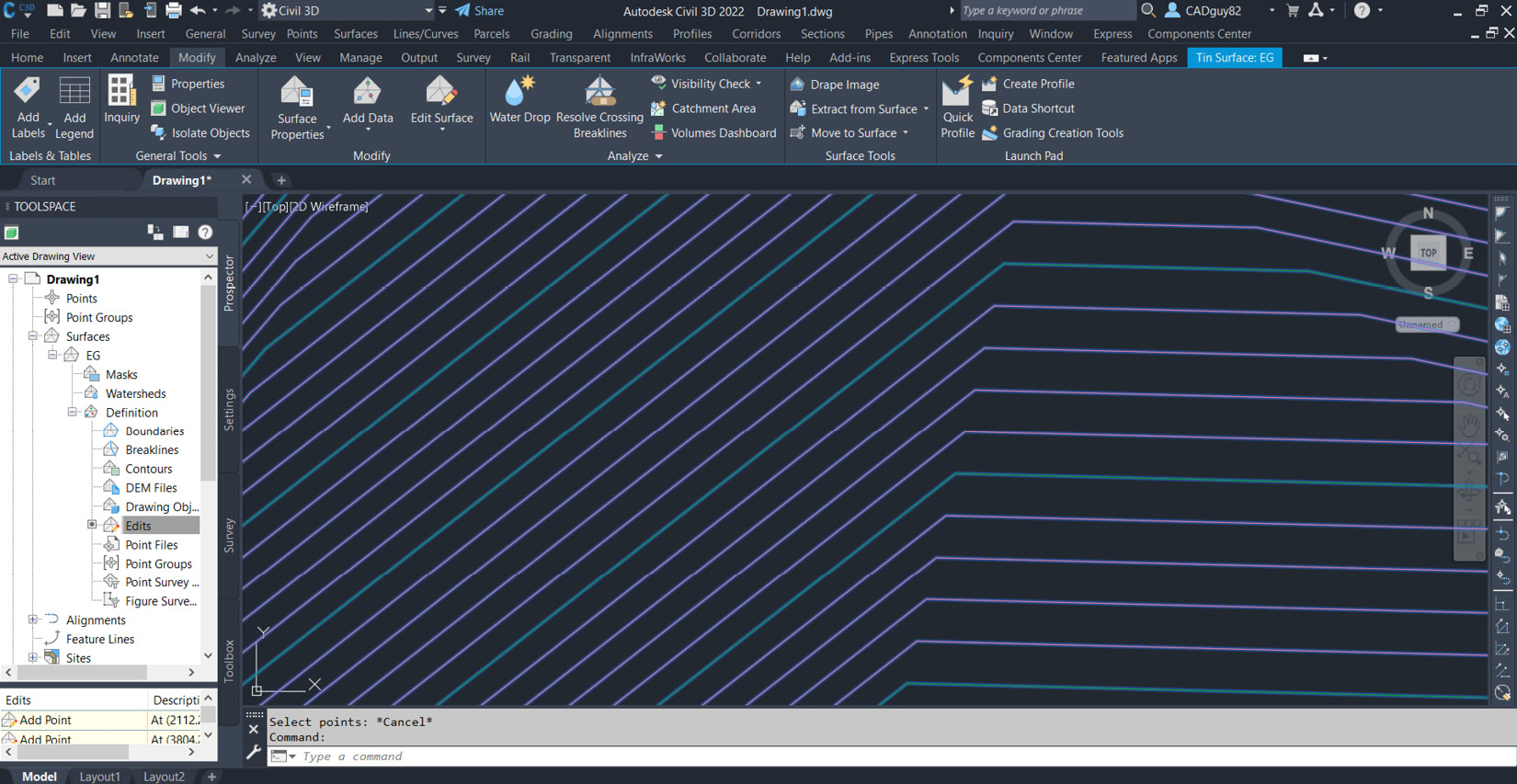
Figure 1.36 – Contextual ribbon when a command or tool is active
The major differences between the displays are the tools and commands that will be made available above your drawing area. The intent of this contextual ribbon is to narrow down the tool selections to what can actually be performed with the identified objects. This eliminates all kinds of unnecessary time trying to remember where to locate tools and ultimately makes your work much easier.
With the contents of the third level behind us, let’s move on to the Toolspace.
Toolspace
The next part of the user interface that we’ll review is Toolspace. This can be accessed by going to the Home tab and selecting the Toolspace icon in the Palettes panel. Once activated, you’ll notice TOOLSPACE being displayed along the left-hand side of your session (refer to Figure 1.37):
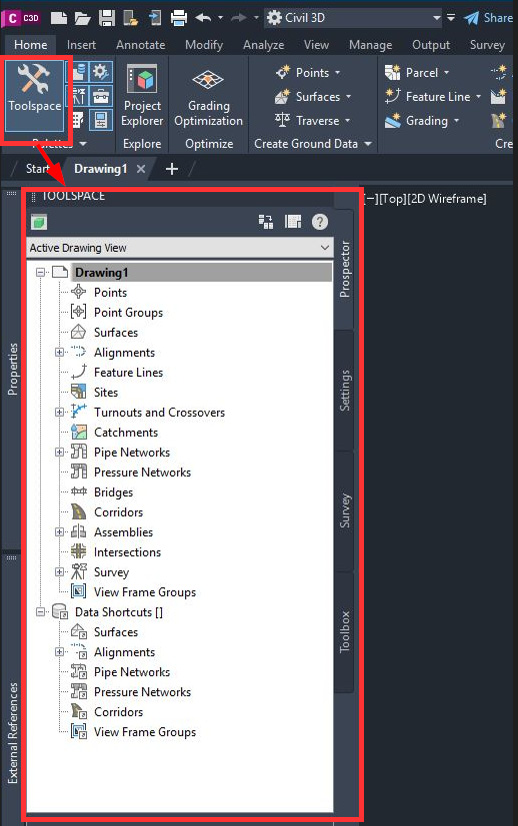
Figure 1.37 – Toolspace access
Within TOOLSPACE, you are presented with a ton of file and design management tools and functionality that will really drive your BIM design and the way modeled geometry and components are displayed. Along the right-hand side of your TOOLSPACE area, you’ll notice four individual tabs that will give you access to each type of functionality, Prospector, Settings, Survey, and Toolbox (refer to Figure 1.38):
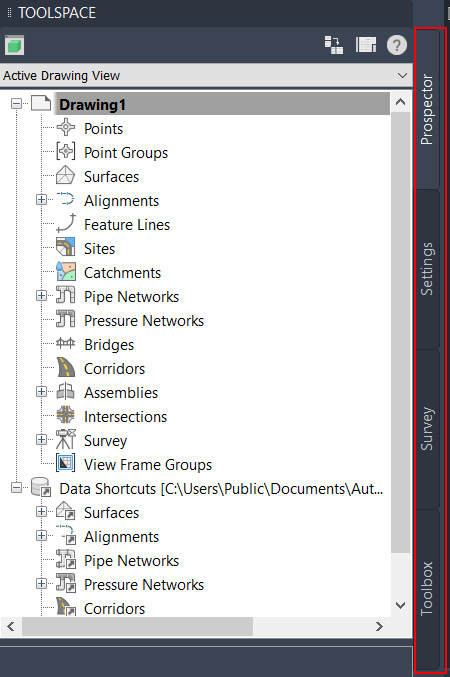
Figure 1.38 – Toolspace tabs
Let’s look at each type of functionality:
- The Prospector tab provides you with the ability to create, modify, analyze, and manage modeled geometry and components within your drawing(s) open in the current session, as well as link modeled geometry and components from other files via Data Shortcuts Manager.
- The Settings tab provides you with the ability to create, modify, and manage settings specific to the drawing(s) open in the current session.
- The Survey tab provides you with the ability to connect to survey databases and manage configurations to streamline the integration of data within Autodesk’s Civil 3D platform.
- The Toolbox tab provides you with additional reporting and analysis tools that work well for gathering information within the current drawing and exporting data to various reporting formats.
With the contents of the toolspace reviewed, let’s now jump into the drawing area.
Drawing area
Moving on, the next area is the drawing area, which is fairly straightforward and self-explanatory. This area is reserved for your actual BIM design modeling, annotating, and so on. All your work will be displayed in this area and will appear as shown in this screenshot:
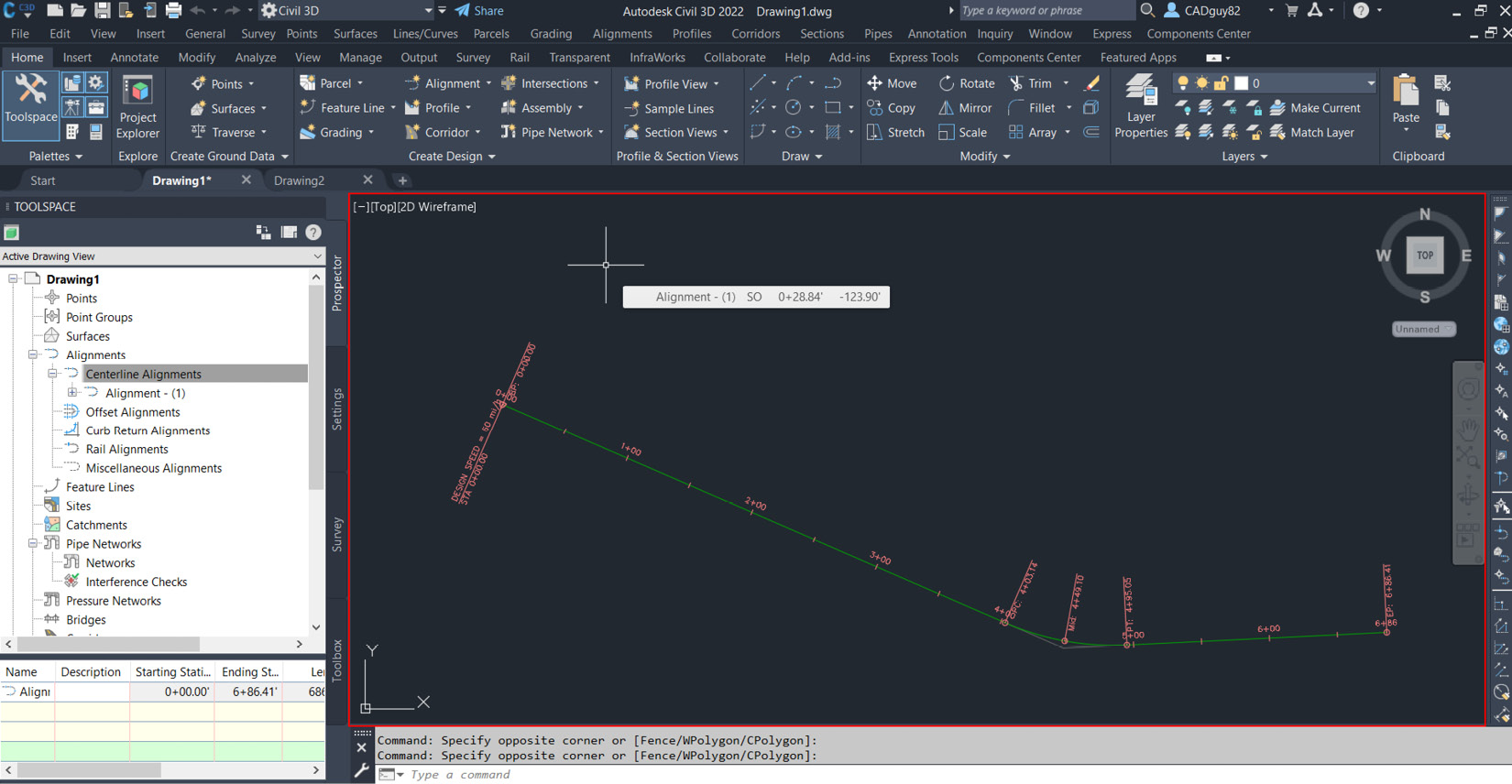
Figure 1.39 – Drawing area
You’ll notice, however, a few different icons within your drawing area that are worth pointing out and providing a little more detail on. In the upper left-hand corner, you’ll notice a few view descriptions, similar to [-] [Top] [2D Wireframe]. When you select each of these fields, you are presented with the ability to further manage and/or change the display of all elements displayed in the drawing area. If you select the first field, [-], you are presented with a few options to customize the drawing area, or model space viewport (shown in Figure 1.40):
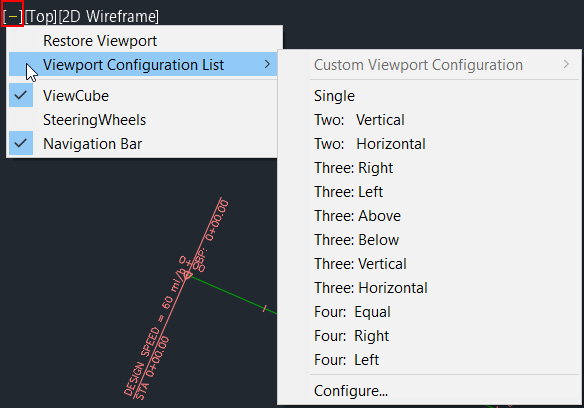
Figure 1.40 – Customize model space viewport
If you select the second field, [Top], you are presented with a few options to customize the orientation of the view being displayed within your model space viewport (shown in Figure 1.41):

Figure 1.41 – Model space viewport view orientation
If you select the third field, [2D Wireframe], you are presented with the ability to change the overall display of your model geometry and components within the model space viewport (shown in Figure 1.42):

Figure 1.42 – Model space viewport display
Let’s move over to the upper right-hand corner of your drawing area. This is where you’ll find ViewCube (refer to Figure 1.43), which allows you to quickly change the user coordinate system (UCS) and view orientation of components displayed in your drawing area. By selecting any of the lettered directions or the rotation options in the top right, or selecting any location on the square/cube located in the center, the view orientation will update as you select each of the options.

Figure 1.43 – ViewCube
Additionally, if you select the down arrow toward the bottom right of ViewCube, you are presented with some additional view settings, along with display options for ViewCube itself (see Figure 1.44):
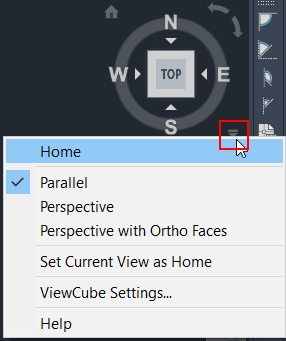
Figure 1.44 – ViewCube settings
Lastly, just underneath ViewCube, you’ll notice a Quick View Access Bar, as shown in Figure 1.45. On this bar, we have the ability to quickly pull up the Full Navigation Wheel that will display right next to your mouse, pan across your drawing (represented by the hand icon), zoom in/out of your view, orbit/rotate your view along an axis, and ShowMotion, which allows you to create animations.

Figure 1.45 – Quick View Access Bar
With the contents of the drawing area reviewed, let’s move on to understanding the command line.
Command line
Last, but not least, we have the command line (refer to Figure 1.46). Any time you are in a command, and not presented with a dialog box, you will see the next steps for your command being displayed at the command line.

Figure 1.46 – Command line
It’s important to keep an eye on the command line if you are in doubt as to what the next step of your command is. Further, if you’re a “typer” like I am, this is also a great place to type any shortcuts of commands instead of trying to locate them within any of the menu dropdowns or sorting through the tools displayed in the ribbons. As an example, you can type the letters CO in the command line and hit Enter or the spacebar to initiate the Copy command, type the letter M and hit Enter or the spacebar to initiate the Move command, and so on.
Now that we have a high-level understanding of what tools are available to us and where they are located within the Autodesk Civil 3D environment, let’s jump into understanding the dynamic nature of the platform to get a little more of an idea as to how best we can leverage it in a BIM design setting.
Understanding Civil 3D elements
Now that we’re getting a little more familiar with the various access points to locate our tools, let’s try to get a better understanding of the overall functionality and capabilities of Autodesk’s Civil 3D. The way this BIM design authoring tool is built allows for multiple design geometry and components to be linked dynamically and, in a way, speak to each other. When one component is updated, it can potentially affect many other components that are built on top of it.
When you think about building a house, you start with a foundation, then you typically frame the house on top of the foundation, and then finish with the walls, roof, doors, windows, insulation, and so on. Thinking about how this workflow applies on the civil engineering side, we typically start with a survey, next we’ll lay out our proposed site geometry as the framework, and then build everything else based on this framework (roadways, utilities, etc.).
Within Autodesk’s Civil 3D, we can create the following intelligent components that have the potential to be linked dynamically to each other:
- Points
- Surfaces
- Sites
- Alignments
- Profiles
- Sections
- Pipe networks (gravity utility networks)
- Pressure networks
- Corridors
Putting each of these in the context of the previously mentioned constructional workflow, each of these components identified in the list is a stepping stone to the next component. If we start with points (surveyed or proposed), we can ultimately create a surface from those points. If a surface is created from those points, and we change the elevation, the surface will dynamically change as well.
Sites, alignments, profiles, and sections would be in closer alignment with the framework concept where we are establishing, or designing, some basic site geometry that our BIM design model will be built on top of, acting as more of a guide.
Then we get into the heart of the design matter, where we jump into pipe networks, pressure networks, and corridors. Yes, we can design some of these BIM design components without establishing the foundational and framework elements, however, we would truly be limited in what we can do from a design standpoint.
That said, we would essentially be setting ourselves up for a lot of questions that can’t be answered later on down the road. By establishing the foundational and framework elements first, we are not only setting ourselves up for a more successful design but also giving ourselves the ability to answer questions about our BIM design models at any given point in time. A thoroughly constructed BIM design model will give you the benefit and assurance in the long run that what is displayed in the drawing area can actually be constructed.
With that, we should have a fairly decent glimpse into how Civil 3D design elements function and how each is, in a way, connected to each other and can truly impact a BIM design.
Summary
In this chapter, we learned about the fundamental navigation tools and Civil 3D elements that will act as the basis for our design as we compound on this chapter going forward. Civil 3D has a very intuitive and adaptive navigation workflow to ensure the analysis and design process transitions seamlessly as we move from step to step.
With the contextual ribbon, the main commands for building upon our design automatically highlight to expedite decision making. Civil 3D provides additional methods of navigation as well as you dive further into specific workflows and begin to customize your method of working.
With a firm understanding of utilizing the navigation tools, we can effectively begin our analysis and design with the core Civil 3D elements. We learned about the different elements within the software and how they respond to different parameters and functions.
In addition to this, we learned about the Civil 3D process that links these elements together in a dynamic way to mitigate redundant work and ensure objects dependent upon each other maintain such integration through the evolution of our designs.
In the next chapter, we will learn about the details of some of these elements and dive further into their inner workings for proper and confident designs. As we explore these new elements in further detail, we will build upon the knowledge of this chapter and demonstrate their dynamic nature in incredibly fast and adaptive workflows as projects change and adjust, as is common with industry work.
Civil 3D is a program that adapts with you at your pace for maintaining focus on the design and not wasting time understanding how the program should work. Successive chapters will build upon the previous chapters, so at any point, if questions arise, feel free to return to those chapters and connect any gaps there may be.
